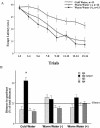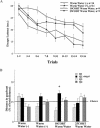A facilitative role for corticosterone in the acquisition of a spatial task under moderate stress
- PMID: 15054134
- PMCID: PMC379689
- DOI: 10.1101/lm.61704
A facilitative role for corticosterone in the acquisition of a spatial task under moderate stress
Abstract
Emotionally charged experiences alter memory storage via the activation of hormonal systems. Previously, we have shown that compared with rats trained for a massed spatial learning task in the water maze in warm water (25 degrees C), animals that were trained in cold water (19 degrees C) performed better and showed higher levels of the stress hormone corticosterone. Here, we examined whether manipulating the levels of corticosterone can determine the strength of spatial information acquisition and retention. Rats were injected with metyrapone (25, 50, and 75 mg/kg, i.p.) or with corticosterone (10 and 25 mg/kg, i.p.) and trained in a massed spatial task in either cold (19 degrees C) or warm (25 degrees C) water. We found that whereas animals injected with vehicle performed well in the spatial task in cold water (moderate stress), rats injected with the intermediate metyrapone dose showed impairment in performance. Moreover, whereas animals injected with vehicle on average did not perform well in warm water (mild stress), rats injected with the lower corticosterone dose showed improvement in performance in warm water. These two mirror experiments of corticosterone blockade and enhancement strongly suggest that corticosterone is instrumental in the acquisition and retention of the spatial learning task.
Figures





References
-
- Akirav, I., Sandi, C., and Richter-Levin, G. 2001. Differential activation of hippocampus and amygdala following spatial learning under stress. Eur. J. Neurosci. 14: 719-725. - PubMed
-
- Alvarado, M.C. and Rudy, J.W. 1995. Comparison of “configural” discrimination problems: Implications for understanding the role of the hippocampus formation in learning and memory. Psychobiology 23: 178-184.
-
- Anderson, C.R. 1976. Coping behaviors as intervening mechanisms in the inverted U stress-performance relationship. J. Appl. Psychol. 61: 30-34. - PubMed
-
- Cahill, L., Pham, C.A. and Setlow, B. 2000. Impaired memory consolidation in rats produced with β-adrenergic blockade. Neurobiol. Learn. Mem. 74: 259-266. - PubMed
-
- Conrad, C.D., Lupien, S.J., Thanasoulis, L.C., and McEwen, B.S. 1997. The effects of type I and type II corticosteroid receptor agonists on exploratory behavior and spatial memory in the Y-maze. Brain Res. 6: 76-83. - PubMed
Publication types
MeSH terms
Substances
LinkOut - more resources
Full Text Sources
Other Literature Sources
